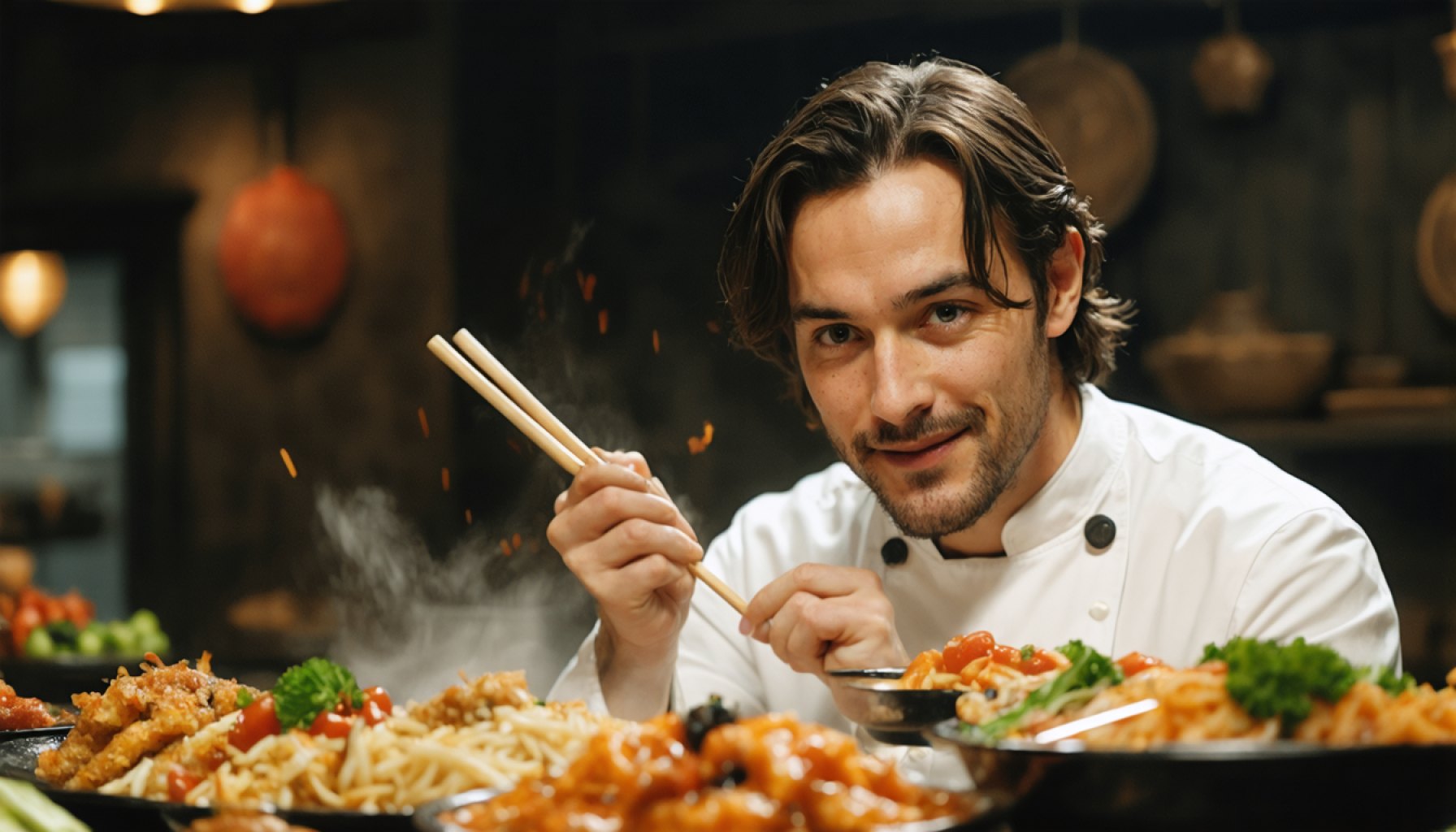- Kyoto’s bustling streets offer hidden culinary gems, as discovered by actor Katsunori Takahashi.
- Takahashi’s culinary adventure highlights the value of patience and anticipation, epitomized by his one-hour wait.
- The restaurant, modest yet inviting, offers a classic Chinese neighborhood eatery ambiance.
- The culinary highlight was a plate of ankake yakisoba, rich in flavor but simple in presentation, accompanied by perfectly seasoned shūmai.
- This gastronomic journey, shared in a blog post, emphasizes the small joys and rewards of patience and dedication.
- The experience resonates with readers, illustrating how simple kitchen experiences can yield rich rewards.
In the heart of Kyoto, a bustling street reveals an unexpected treasure trove of scents and flavors. Actor Katsunori Takahashi recently embarked on a culinary journey that epitomizes patience and reward. Drawn by a friend’s recommendation, he stood in line under a sky that shifted from sunny to snow-kissed, clutching a book to pass the time. For one hour, he waited—proof that good things, indeed, come to those who wait.
Once inside, Takahashi found a surprising oasis. The restaurant’s interior, modest yet inviting, captured the essence of a classic neighborhood Chinese eatery, with ample space to savor each bite unfettered by crowding. The anticipation built slowly, akin to waiting for a film’s climax. Then, the culinary symphony began.
A steaming plate of ankake yakisoba stood at the forefront—a dish deceptively simple in appearance yet bursting with nuanced, gentle flavors intermingling with the piquant tang of mustard. Takahashi described this harmony as nothing short of enchanting. Alongside, plump shūmai delivered mouthfuls of delight, embodying the subtle art of restraint and balance in seasoning.
This gastronomic experience, shared through a blog post, resonated with readers who relished the vicarious taste of dedication—willpower measured by the ticking of a clock. Such endeavors remind us of the small joys worth the wait, where patience transforms into flavorful satisfaction. As Takahashi proved, sometimes the richest rewards emerge from the simplest, quietest kitchens.
This Hidden Gem in Kyoto Will Change Your Culinary Expectations Forever!
How-To Steps & Life Hacks for Visiting Hidden Restaurants
Taking a page from Katsunori Takahashi’s culinary adventure can enhance your dining escapades. Here are step-by-step tips:
1. Research Before You Go: Use platforms like Google Maps, Yelp, or local foodie blogs to find off-the-beaten-path eateries.
2. Plan for Peak Times: Aim to arrive slightly before peak meal periods to reduce wait times.
3. Pack a Leisure Kit: Bring a book or download podcasts to make waiting more enjoyable.
4. Connect with Locals: Engage with residents or staff to discover the backstory and recommended dishes of the restaurant.
5. Savor the Experience: Once inside, take the time to appreciate the ambiance and flavors, as the experience is as much about patience as taste.
Real-World Use Cases
This story emphasizes the value of patience and exploration:
– Culinary Tourism: For those traveling to Japan or other countries, seeking out local hidden gems can offer unique insights into traditional cuisine.
– Mindfulness in Everyday Life: Adopting a mindset that treasures anticipation and discovery can be applied to various aspects of life, from dining to personal projects.
Market Forecasts & Industry Trends
The rise of culinary tourism is expected to grow, with the global culinary tourism market projected to reach $2.1 trillion by 2032, growing at a CAGR of 16% (Research and Markets). The trend leans towards authentic, local experiences—favoring humble, traditional venues over extravagant dining.
Reviews & Comparisons
Though monumental restaurants offer renowned fine dining experiences, smaller establishments like the one Takahashi visited provide priceless cultural insights:
– Advantages: Authentic flavors, cultural immersion, personal service, and affordability.
– Negatives: Limited seating, longer wait times, and variability in quality.
Controversies & Limitations
While such dining experiences are cherished, they often have hidden challenges:
– Accessibility Issues: Some of these locations might not be accessible to people with disabilities due to traditional architecture.
– Long Queues: Waiting times can detract from the overall experience, making it less appealing to those with limited time.
Features, Specs & Pricing
While the restaurant Takahashi visited is not publicly named, typical features of a traditional, family-run Chinese restaurant in Kyoto might include:
– Modest Decor: Simple and authentic aesthetic with little focus on lavish interiors.
– Budget-Friendly Prices: Typically, dishes range from $8 to $20, offering value for money.
Security & Sustainability
Small eateries often have sustainability measures naturally built into their operations:
– Locally Sourced Ingredients: Using seasonal and local produce reduces transport emissions and supports local farmers.
– Minimal Waste Policy: Smaller menus typically result in less food waste.
Insights & Predictions
The interest in authentic dining will likely spur an increase in such hidden gems, especially in culturally rich regions like Kyoto. Future travelers will prioritize experiences over extravagant presentations, seeking genuine connections with local traditions.
Tutorials & Compatibility
To make the most of your visit to a traditional restaurant:
– Language Tools: Use translation apps like Google Translate to ease communication barriers.
– Payment Options: Always have local currency on hand, as small establishments may not accept credit cards.
Pros & Cons Overview
Pros:
– Unique, authentic culinary experiences
– Opportunities for cultural immersion
– Lower cost compared to high-end dining
Cons:
– Inconsistent quality
– Potential accessibility limitations
– Longer waiting times
Actionable Recommendations
1. Embrace Patience: Incorporate patience into your dining explorations to unlock unexpected flavors and stories.
2. Support Local: Prioritize family-run eateries that contribute to local economies and sustainability.
3. Document the Journey: Share your experiences through a blog or social media to encourage others to explore culinary paths less traveled.
For more information on travel and food adventures, visit the Lonely Planet website.
